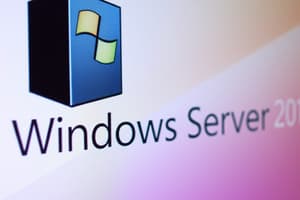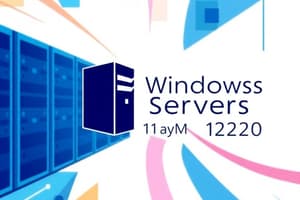Podcast
Questions and Answers
What determines the functions a server performs?
What determines the functions a server performs?
- The operating system installed
- The size of the business and its commitment to technology (correct)
- The type of hardware used
- The price of the server
Which of the following is a function of a server operating system?
Which of the following is a function of a server operating system?
- Running background processes for network services (correct)
- Providing antivirus protection
- Emphasizing desktop application performance
- Improving gaming performance on local machines
What is the maximum number of virtual instances permitted by the Standard Edition?
What is the maximum number of virtual instances permitted by the Standard Edition?
- Ten
- Unlimited
- Twenty
- Two (correct)
Which of these services is provided by Windows Server 2012/R2?
Which of these services is provided by Windows Server 2012/R2?
Which edition requires a license CAL for each user who logs on to the server?
Which edition requires a license CAL for each user who logs on to the server?
How many maximum logged-on network users does Windows 10 support?
How many maximum logged-on network users does Windows 10 support?
What is the maximum amount of RAM supported by the Foundation Edition?
What is the maximum amount of RAM supported by the Foundation Edition?
Which of the following is NOT an edition of Windows Server 2012/R2?
Which of the following is NOT an edition of Windows Server 2012/R2?
Which feature is automatically configured in the Essential Edition?
Which feature is automatically configured in the Essential Edition?
How many physical processors can the Foundation Edition support?
How many physical processors can the Foundation Edition support?
The Datacenter Edition allows an unlimited number of virtual instances to be installed.
The Datacenter Edition allows an unlimited number of virtual instances to be installed.
The Foundation Edition supports up to 32 GB of RAM.
The Foundation Edition supports up to 32 GB of RAM.
Both the Essential Edition and Foundation Edition are aimed at small businesses.
Both the Essential Edition and Foundation Edition are aimed at small businesses.
To use the Standard Edition, no client access licenses (CALs) are required.
To use the Standard Edition, no client access licenses (CALs) are required.
The Essential Edition comes with a management interface called Dashboard.
The Essential Edition comes with a management interface called Dashboard.
The functions a server performs depend only on the size of the business.
The functions a server performs depend only on the size of the business.
Windows 10 can perform server functions such as file and printer sharing.
Windows 10 can perform server functions such as file and printer sharing.
Windows Server 2012/R2 allows for up to 50 logged-on network users.
Windows Server 2012/R2 allows for up to 50 logged-on network users.
Active Directory controls login for users in a network.
Active Directory controls login for users in a network.
RAID 5 is a feature that supports fault tolerance in Windows Server 2012/R2.
RAID 5 is a feature that supports fault tolerance in Windows Server 2012/R2.
What is a crucial hardware consideration when installing Windows Server 2012/R2?
What is a crucial hardware consideration when installing Windows Server 2012/R2?
Why is it necessary to consider the server's name during installation?
Why is it necessary to consider the server's name during installation?
During a clean installation of Windows Server 2012/R2, which step is essential after installation?
During a clean installation of Windows Server 2012/R2, which step is essential after installation?
What is recommended regarding IP addressing for a server after installation?
What is recommended regarding IP addressing for a server after installation?
What installation process involves installing the OS on a new disk partition without upgrading?
What installation process involves installing the OS on a new disk partition without upgrading?
What is one of the main reasons for expanding a network or adding servers?
What is one of the main reasons for expanding a network or adding servers?
What is a benefit of adding a second domain controller?
What is a benefit of adding a second domain controller?
Which of the following is NOT considered a post installation task for Windows Server 2012 R2?
Which of the following is NOT considered a post installation task for Windows Server 2012 R2?
Which type of domain controller can benefit branch offices particularly well?
Which type of domain controller can benefit branch offices particularly well?
What is a service pack in the context of Windows Server updates?
What is a service pack in the context of Windows Server updates?
Activation for Windows Server 2012 R2 must be completed within 10 days after installation.
Activation for Windows Server 2012 R2 must be completed within 10 days after installation.
A read only domain controller (RODC) cannot be used in an existing domain.
A read only domain controller (RODC) cannot be used in an existing domain.
Deployment of a static IP address is not a recommended post installation task.
Deployment of a static IP address is not a recommended post installation task.
Windows Update is responsible for downloading and installing new features and security patches.
Windows Update is responsible for downloading and installing new features and security patches.
Fault tolerance in Windows Server roles, such as DNS and AD DS, is optional.
Fault tolerance in Windows Server roles, such as DNS and AD DS, is optional.
Windows Server 2012/R2 supports a maximum of 64 physical CPUs.
Windows Server 2012/R2 supports a maximum of 64 physical CPUs.
A clean installation of Windows Server 2012/R2 involves upgrading from a previous version.
A clean installation of Windows Server 2012/R2 involves upgrading from a previous version.
Windows Server 2012/R2 uses automatic IP addressing by default.
Windows Server 2012/R2 uses automatic IP addressing by default.
The Administrator password for Windows Server 2012/R2 must contain at least three characters and can use any character type.
The Administrator password for Windows Server 2012/R2 must contain at least three characters and can use any character type.
Hot-add features allow memory or CPU to be added only when the system is shut down.
Hot-add features allow memory or CPU to be added only when the system is shut down.
Flashcards
What is a server?
What is a server?
Software installed on a computer that provides services to other computers on a network, enabling operations for an organization.
What are server operating systems?
What are server operating systems?
The software installed on a server that allows it to perform specific tasks, like sharing files, managing user logins, or hosting websites.
What are the key features of server OS?
What are the key features of server OS?
Operating systems designed to prioritize network access performance and run background processes, making them ideal for server applications.
What is fault tolerance in a server?
What is fault tolerance in a server?
Signup and view all the flashcards
What are the different editions of Windows Server 2012/R2?
What are the different editions of Windows Server 2012/R2?
Signup and view all the flashcards
Windows Server Essential Edition
Windows Server Essential Edition
Signup and view all the flashcards
Windows Server Foundation Edition
Windows Server Foundation Edition
Signup and view all the flashcards
Windows Server Datacenter Edition
Windows Server Datacenter Edition
Signup and view all the flashcards
Windows Server Datacenter Edition with Hyper-V
Windows Server Datacenter Edition with Hyper-V
Signup and view all the flashcards
Server Core
Server Core
Signup and view all the flashcards
What is a web server?
What is a web server?
Signup and view all the flashcards
What is DNS (Domain Name System)?
What is DNS (Domain Name System)?
Signup and view all the flashcards
What is DHCP (Dynamic Host Configuration Protocol)?
What is DHCP (Dynamic Host Configuration Protocol)?
Signup and view all the flashcards
What is load balancing?
What is load balancing?
Signup and view all the flashcards
Windows Server 2012/R2 Essential Edition
Windows Server 2012/R2 Essential Edition
Signup and view all the flashcards
Windows Server 2012/R2 Foundation Edition
Windows Server 2012/R2 Foundation Edition
Signup and view all the flashcards
Clean installation
Clean installation
Signup and view all the flashcards
Hot-add/hot-replace
Hot-add/hot-replace
Signup and view all the flashcards
Server Manager
Server Manager
Signup and view all the flashcards
Administrator password
Administrator password
Signup and view all the flashcards
Domain Controller
Domain Controller
Signup and view all the flashcards
Read Only Domain Controller (RODC)
Read Only Domain Controller (RODC)
Signup and view all the flashcards
Patches
Patches
Signup and view all the flashcards
Service Pack
Service Pack
Signup and view all the flashcards
CPU Architecture
CPU Architecture
Signup and view all the flashcards
Workstation vs. Server Processors
Workstation vs. Server Processors
Signup and view all the flashcards
Hot-add/hot-replace Features
Hot-add/hot-replace Features
Signup and view all the flashcards
Static IP Address
Static IP Address
Signup and view all the flashcards
What is a Domain Controller?
What is a Domain Controller?
Signup and view all the flashcards
What is a Read Only Domain Controller (RODC)?
What is a Read Only Domain Controller (RODC)?
Signup and view all the flashcards
When is a Server Core installation suitable?
When is a Server Core installation suitable?
Signup and view all the flashcards
What are software patches?
What are software patches?
Signup and view all the flashcards
What is a Service Pack?
What is a Service Pack?
Signup and view all the flashcards
Study Notes
Server Functions
- Server functions depend on the type of business, its size, and the extent of technological use for operations.
- Server functions include services such as Active Directory (managing logins), DHCP (dynamic IP addressing), DNS (domain naming), email, and various other services to support organizational operations.
Computer as Server
- A computer becomes a server when software is installed to provide network services to client computers.
- Operating systems like Windows 10/11 are designed for desktop computers but can also perform server functions (like file/printer sharing).
- Server operating systems prioritize network performance and background processes over desktop applications.
Windows Server 2012/R2 Network Services
- File and Printer Sharing: Allows multiple users to access shared folders and a single printer.
- Web Server: A server that hosts Websites.
- Routing and Remote Access Services (RRAS): Manages network connectivity and routing.
- Domain Name System (DNS): Translates domain names into IP addresses.
- Dynamic Host Configuration Protocol (DHCP): Automatically assigns IP addresses to client machines.
- File Transfer Protocol (FTP) Server: Transfers files between computers.
- Active Directory: Controls user accounts, permissions, and network resources.
- Distributed File System (DFS): Manages shared files across the network.
- Hyper-V: Allows running multiple virtual machines on a single physical server.
- Windows Networking: Provides essential networking functionalities within the server environment.
Supported Users
- Windows 10 desktops support limited network services and a maximum of 20 logged-on users.
Fault Tolerance
- Windows Server 2012/R2 supports fault tolerance (Redundant Array of Independent Disks [RAID] 5 and load balancing).
Windows Server 2012/R2 Editions
- Datacenter, Standard, Essential, and Foundation editions are available.
- Businesses can choose the appropriate edition based on their needs and services required.
- Datacenter Edition allows an unlimited number of virtual instances, and supports up to 64 physical processors and potentially unlimited nodes per cluster.
- Standard Edition has similar features to Datacenter but with limitations on the number of virtual instances (dual-core only).
- Essential Edition is for small businesses (25 or fewer users) and easily configured. Including core services (Active Directory Certificate Services, DNS, File Services, Web Server (IIS), Network Policy Server, and Remote Desktop Services).
- Foundation Edition is suitable for smaller businesses without large numbers of users (limited to 15 users), with further limitations on processors and RAM. It supports only one physical processor.
Cloud Computing and Virtualization
- Cloud computing abstracts computing resources from users.
- Virtualization uses software to create multiple hardware environments on a single physical server.
Virtual Machines (VMs)
- A virtual machine (VM) is a software-based emulation of a physical computer.
- A host computer runs VM software and acts as the physical hardware environment for VMs.
- Virtualization software manages VMs.
Cloud Types
- Public Cloud: Provided by third parties.
- Private Cloud: Provided by an internal IT department.
Virtual Desktop Infrastructure (VDI)
- Users can access virtual desktops via specific software or browser.
Windows Server 2012/R2 Core Technologies
- Server Manager: A single interface for managing servers.
- Active Directory: Centralized management for network resources.
- Disk Management: Manages disks and volumes.
- File and Printer Sharing: Facilitates file sharing and printer access.
- File Transfer Protocol (FTP) Server: Transfers files between computers.
- Active Directory Certificate Services (AD CS): Provides services for creating, issuing, and managing digital certificates.
- Active Directory Domain Services (AD DS): Turns a Windows server into a domain controller. This role is required to manage authentication.
- Dynamic Host Configuration Protocol (DHCP) Server: Automatically assigns IP addresses to clients.
- Windows Networking: Provides essential networking functionalities within the server environment.
- IP Address Management (IPAM): Monitors and manages DHCP and DNS servers, enabling auditing and tracking of address changes.
Network Concepts
- Workgroup Model: A simple, decentralized network structure for small groups (fewer than 10).
- Domain Model: A more complex, centralized network structure for larger groups. Requires a domain controller for authentication.
Server Roles
- Server role: A major function or service performed by a server.
- Role service: Adds functions to the main role.
- Server features: Enhances or supports an installed role.
Digital Certificates
- Electronic documents containing identity information.
- Active Directory Certificate Services (AD CS) provides services for creating, issuing, and managing digital certificates.
Domain Controller Features
- A central point for authentication and authorization in a Windows domain.
- Manages domain resources and users.
DHCP Server Role
- Automatically assigns IP addresses to network clients.
- A DHCP Server role allows for configurable default gateway, DNS server settings, and other options.
Windows Deployment Services
- Simplifies large-scale Windows installations and configurations over a network.
PowerShell
- A command-line scripting environment for server management.
- Hundreds of cmdlets available for simple and complex tasks.
IP Address Management (IPAM)
- Monitors and manages DHCP and DNS servers within a domain.
- Audits IP address use and tracks changes.
Server Hardware and Software
- Servers are defined by the software running on their hardware.
- Windows Server 2012/R2 is available in four editions: Datacenter, Standard, Essentials and Foundation.
- Additional services (like Minimal Server Interface, Storage Spaces, Resilient File System, IP Address Management, and Dynamic Access Control) are included.
Studying That Suits You
Use AI to generate personalized quizzes and flashcards to suit your learning preferences.




